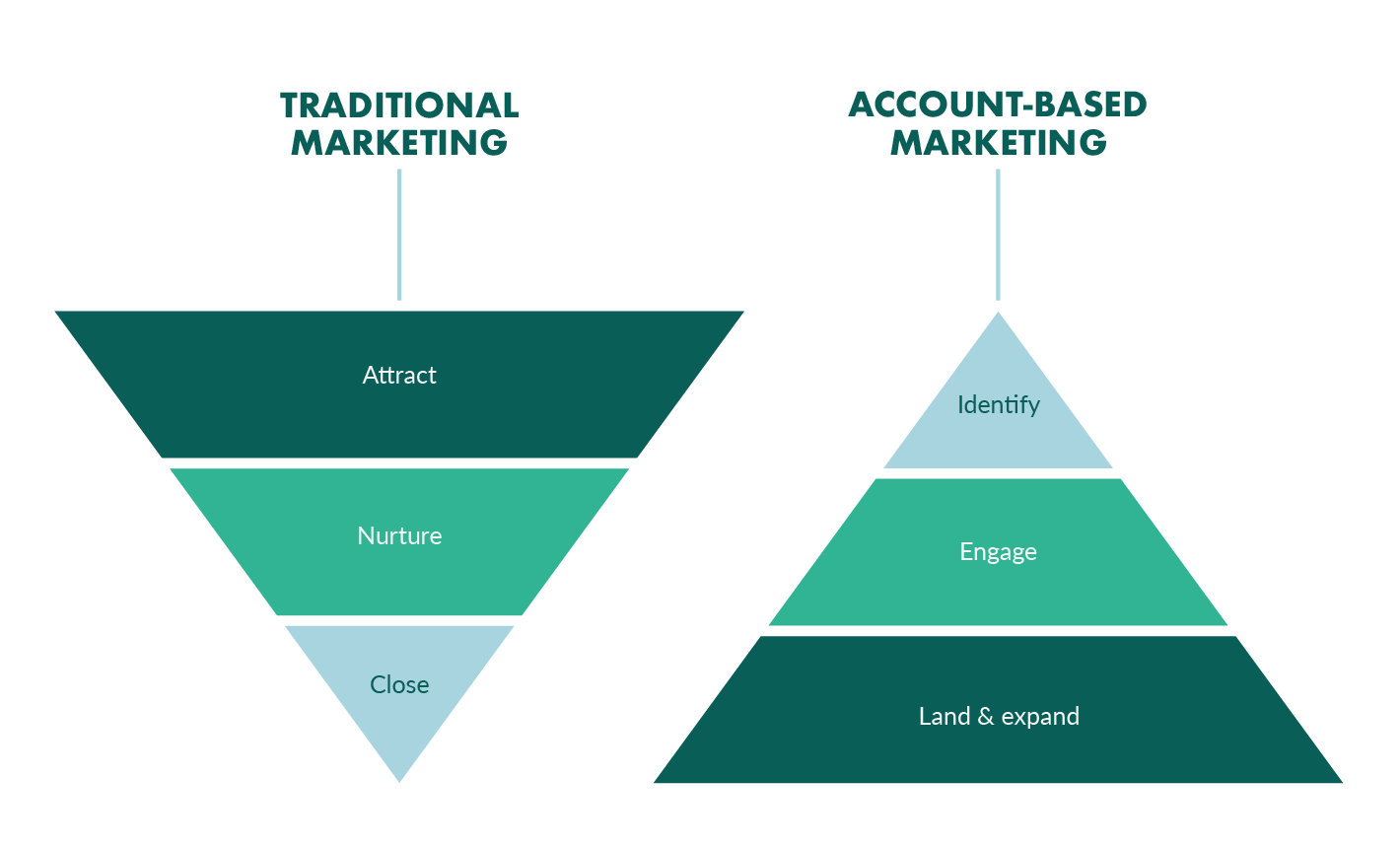Account-based marketing (ABM) or Account Marketing is a variant of traditional marketing that consists of designing a strategy to attract the exact customer profile (or accounts) that we want. Generally, this need to attract the ideal customer arises in B2B companies with a smaller market.
On the one hand, in traditional marketing the dynamic is: attract the lead, create a relationship with him, he becomes a qualified lead (who has contacted the company, a stage before conversion) and finally we try to convert him into a real customer. In ABM, the idea is to reverse this process (conversion funnel). First we identify interesting accounts, then we attract leads with personalized content for them and finally we create long-term relationships.
Llevar a cabo esta estrategia de marketing no siempre será lo más adecuado. En este post vamos a enseñarte cuándo es recomendable aplicar el Account Based Marketing. Si quieres saber más sobre las etapas de un proceso de venta tradicional, consulta nuestro post Embudo de ventas: cómo conseguir leads y convertirlos en clientes reales.
Carrying out this marketing strategy will not always be the most appropriate. In this post we will show you when it is advisable to apply Account Based Marketing. If you want to know more about the stages of a traditional sales process, see our post Sales funnel: how to get leads and convert them into real customers.


In which companies should Account Based Marketing be applied?
If you identify with any of these situations, then you can consider applying ABM in your business model.
Companies with small markets. Here we refer to companies with few potential customers, which can easily identify all the opportunities (all the customers likely to purchase their products or services) in the market in which they operate.
The value of each sale is high. There are customers that can be acquired profitably, are easy to retain and account for a significant portion of the company’s turnover. These are high value customers (based on Customer Lifetime Value).
Beneficios de una estrategia de Account Based Marketing (ABM)
- Efficient to capture ideal clients and not generic leads.
- It only sends personalized information to customers, thus improving their experience and engagement (communications are not perceived as spam).
- Increases customer life time value (LTV) and retention rates
- It has a better ROI (return on investment) than other strategies.
- The phases of this strategy are easy to optimize.
- Increases the probability of closing a sale.
5 phases to implement an Account Based Marketing strategy
Implementing an Account Marketing strategy is not difficult as long as all the phases of the sales process are clear and the accounts (leads) are well identified. In addition, a good coordination between the sales and marketing departments will be needed.
These are the steps to follow in the implementation of ABM:
1. Choose the accounts you want to target.
This is the first and most important phase, because if you make a mistake in defining the customer profile you want to target, the rest of the strategy will fail. Make a list of the companies you are interested in. To segment, you can choose to hire a consultant specialized in ABM or work on your own using segmentation tools such as Linkedin’s Sales Navigator.
2. Identify each profile and what information you want to convey to them.
Once you have chosen the accounts you are going to target, identify the buyer personas within each account. Remember that the basis of this strategy is personalization. Therefore, you will have to create information tailored to each of these profiles and send personalized content to all the people involved in the target account’s decisions. This is how different strategies emerge:
- ABM one to one: You choose a small number of companies and give a personalized treatment to each one. Here it is important to take into account the buyers persona.
- ABM one to few: You identify that there are different groups of companies with common characteristics and decide to create a similar strategy for each cluster, without forgetting personalization.
- ABM one to many: Here the level of personalization is not very high (similar to Inbound Marketing) since the objective is to reach the largest number of accounts.
3. Design the contact strategy.
It is time to choose through which media you are going to contact the customer. In order of effectiveness, we can say that the most used tactics are the following:
- Email and telephone. A manager is in charge of contacting potential customers with phone calls or emails during the day.
- Event organization.
- Outreach marketing. Build long-term beneficial relationships with professionals in your business area, industry leaders and suppliers.
- Direct Mail. E-mail advertising. It is not contact as in the first medium. Here you send content.
- Digital Advertising. Includes search engine marketing, social networks, mobile advertising…
- Content creation.
- Linkedin. An ideal social network to contact professional profiles.
4. First contact with the lead.
Create a landing page with a contact form for the buyer persona to leave their data. Here you will have a first approximation of the profile of this customer and you will be able to choose whether it is the right one or not. This is a marketing technique known as “lead nurturing”, a key phase between this first contact and conversion.
If you determine that the customer interests you, start interacting with him and keep in touch so as not to lose him in the sales process. If the sale is closed and they become a real customer, the idea is to build loyalty so that their LTV increases over time.
5. Measurement of results.
As with any strategy, it is very important to check the results it is having. That is, if the objectives you have set are being met. You can measure, for example, the increase in sales.
Conclusion
If your business strategy wasn’t working and you think Account Based Marketing could be a good fit for your company, follow these tips to implement it today, I hope I’ve helped you!


